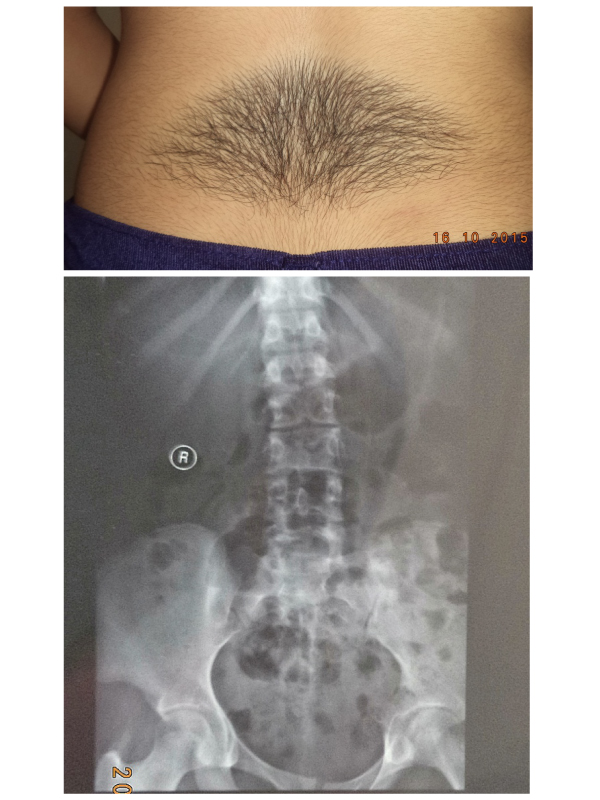2376-0249
Case Blog - International Journal of Clinical & Medical Images (2016) Volume 3, Issue 7

Author(s): Tasleem Arif, Mohammad Adil, Syed Suhail Amin and Konchok Dorjay
Introduction: Nevoid hypertrichosis is a rare disease characterized by the presence of terminal hair in a circumscribed distribution present since birth [1] The disorder has been associated with abnormalities of skin and other organs. We present a case of nevoid hypertrichosis associated with spinal dysraphism.
Case Presentation: A 14 year old female presented with a patch of hair on her lower back since infancy (Figure 1). There was history of prolonged low backache. The antenatal and birth history was uneventful. Developmental milestones achieved by her were normal for age. There was no history of urinary or fecal incontinence or lower limb weakness. On examination, a well-defined patch of terminal, dark hair was noted on the lumbosacral region in the midline, though a tuft of hair was not present. Underlying skin was normal. No other cutaneous or mucosal abnormality was noted in the patient. No sensory or motor deficit was elicited. Pelvic radiograph (anteroposterior view) revealed spina bifida at L5 level and scoliosis (Figure 2). No other bony or articular abnormality was found. Vertebral height and intervertebral disc spaces were maintained. Soft tissue appeared to be normal. Based on history and examination, a diagnosis of nevoid hypertrichosis with spina bifida was made.
Discussion: Nevoid hypertrichosis is the presence of well-defined patch of terminal hair present since birth, though it may develop some time after birth as well. Though usually single, it may be multiple and may be present along Blaschko’s lines [2]. Reports of depigmented hair also exist [3]. Several case reports suggest an association with cutaneous hypopigmentation, hypertrichosis cubiti and disorders of the eye, face, nails, bones, teeth, central nervous system, gastrointestinal system and respiratory system [4].
Nevoid hypertrichosis has to be differentiated from other causes of congenital hypertrichoses like congenital melanocyticnevus, congenital smooth muscle hamartoma and Becker’s nevus. Faun tail deformity is a localized hypertrichosis presenting on the lumbosacral region with a tuft of terminal hair and associated with spinal cord defects. Our patient had features similar to faun tail, but a tuft of hair was absent. Nevoid hypertrichosis persists for life and treatment might be sought for cosmetic reasons. Lasers can be used for hair reduction. Spontaneous resolution of the nevoid hypertrichosis has also been reported [5]. Conclusion This case highlights the fact that patients of nevoid hypertrichosis need to be investigated for other systemic abnormalities.
 Awards Nomination
Awards Nomination

